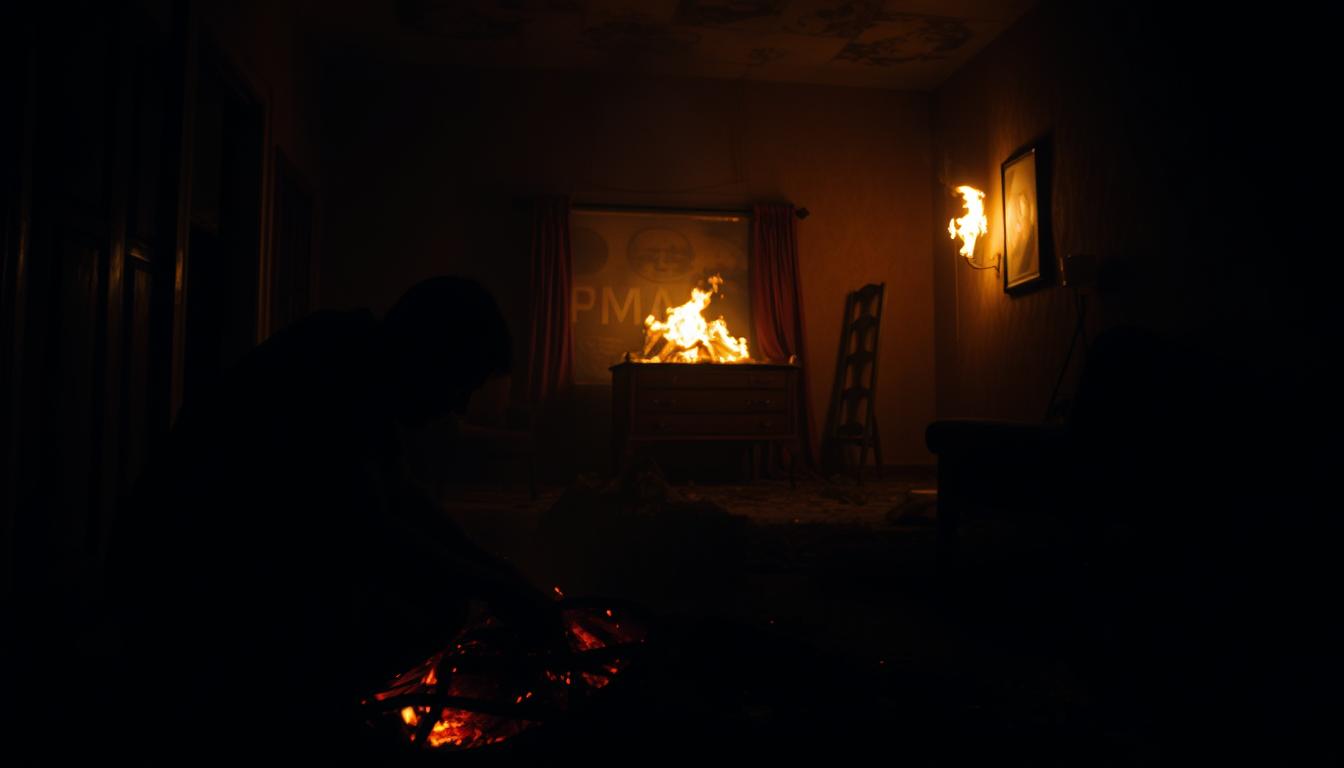Every year, thousands of properties are damaged by intentional fires. These fires cause huge financial losses and, sadly, loss of life. Aggravated arson is a serious crime. It involves setting fire to a property on purpose, causing a lot of damage or harm to people.

I will look into the legal definition of aggravated arson. We will also explore the penalties for it. Understanding these points is key to seeing how serious this crime is.
Key Takeaways
- Aggravated arson involves intentionally setting fire to a property, resulting in significant damage or harm.
- The legal definition of aggravated arson varies by jurisdiction but generally involves intentional acts.
- Criminal charges for aggravated arson can lead to severe penalties, including lengthy prison sentences.
- Aggravated arson is distinguished from simple arson by the severity of the damage or harm caused.
- Investigations into aggravated arson are thorough and often involve forensic analysis.
Understanding Arson: The Foundation of Fire-Related Crimes
Arson is key to understanding fire-related crimes. It’s the act of setting fire to a property on purpose. This can be buildings, vehicles, or other structures.
Basic Definition of Arson in Criminal Law
Arson is seen as malicious burning of property. It’s done with the aim to damage or destroy. This basic idea helps form the basis of more complex fire crimes.
Historical Development of Arson Laws in the United States
Arson laws in the U.S. have changed a lot over time. At first, they mainly aimed to protect property. As society and laws grew, so did arson laws. Now, they cover a wider range of crimes and penalties.
The Evolution of Fire-Related Offenses
Fire crimes have become more complex. Modern laws tackle different types of arson. This includes aggravated arson, which is more serious. It involves risks to people’s lives or big property damage.
Knowing the basics, history, and growth of arson laws helps us get the big picture. This includes understanding aggravated arson and its legal side.
What Is Aggravated Arson: Legal Definition and Key Elements
Aggravated arson is a serious crime with its own legal definition. It has key elements that set it apart from other arson crimes. This makes it a grave offense under the law.
Core Legal Definition Under Federal Law
Under federal law, aggravated arson is setting fire to a property on purpose. It causes big damage or harm to people. This law covers both the act of arson and its severe effects.
Essential Elements Required to Constitute Aggravated Arson
To be considered aggravated arson, some key elements must be there. These include:
- Intentional Fire Setting: The fire must be set on purpose, not by accident.
Intentional Fire Setting
- The person setting the fire must do it on purpose. They must know the harm it could cause.
- Presence of Aggravating Circumstances: Certain factors, like people in the building or big damage, make it aggravated arson.
Presence of Aggravating Circumstances
- Aggravating factors include risks to firefighters, big financial losses, or fires in crowded areas.
Criminal Intent Requirements
To prove aggravated arson, the intent of the perpetrator must be shown. It must be clear that the act was intentional and knew of the harm it could cause.
Prosecutors need to show the defendant set the fire on purpose. They also need to prove aggravating factors were there. Knowing these elements helps understand the crime’s severity and the penalties.
Aggravated Arson vs. Simple Arson: Critical Differences
It’s important to know the difference between aggravated arson and simple arson. Both involve setting fire to property, but the severity varies. The key differences are in the circumstances and the harm caused.
Comparative Analysis of Legal Elements
Simple arson is when someone sets fire to property without thinking about people’s safety. Aggravated arson, on the other hand, involves actions that risk people’s lives or cause a lot of damage.
Key differences include:
- Presence of people in the affected property
- Extent of damage caused by the fire
- Use of accelerants or other aggravating factors
Severity Factors That Elevate Simple Arson to Aggravated Arson
Several factors can make simple arson into aggravated arson. These include people being in the building, a lot of financial loss, or using explosives.
| Factor | Simple Arson | Aggravated Arson |
|---|---|---|
| Presence of Occupants | No occupants | Occupants present |
| Financial Loss | Minimal | Significant |
| Use of Explosives | No explosives used | Explosives used |
Case Examples Illustrating the Distinction
For example, setting fire to an empty building might be simple arson. But, setting fire to a house with people inside is aggravated arson. This is because it puts lives at risk.
Elements Prosecutors Must Prove in Aggravated Arson Cases
Prosecutors have a big job in aggravated arson cases. They must prove several key points beyond a doubt. They need to show the defendant’s intent, the act of setting the fire, and the factors that make it aggravated arson.
Establishing Criminal Intent (Mens Rea)
The first thing is to prove the defendant’s intent, or mens rea. This means showing they set the fire on purpose or knew it would happen. The intent could be to damage property or harm people.
Proving the Physical Act (Actus Reus)
Prosecutors also need to prove the defendant set the fire, known as actus reus. They must show the defendant was involved in setting the fire. They use evidence like witness statements, videos, or forensic analysis to link the defendant to the crime.

Demonstrating Aggravating Factors
Aggravating factors make the arson more serious. Prosecutors must show the defendant’s actions caused significant harm or risk.
Endangerment of Human Life
One aggravating factor is if the fire endangered people. If the fire was a big risk to those nearby, it’s considered serious. Prosecutors must prove the defendant’s actions could have seriously harmed or killed others.
Property Value Considerations
Another factor is the property’s value. If the property was very valuable, it shows the crime was more severe. Prosecutors might show how much the property was worth and the extent of the damage.
| Aggravating Factor | Description | Impact on Sentencing |
|---|---|---|
| Endangerment of Human Life | Risk to people in or around the property | Increased sentence severity |
| Property Value | Monetary or sentimental value of the property | Enhanced penalties for significant damage |
Burden of Proof Standards
In aggravated arson cases, the prosecution must prove the defendant’s guilt beyond a reasonable doubt. This is the highest standard in the legal system. Prosecutors must present strong evidence that leaves no doubt about the defendant’s guilt.
Understanding these elements is key for prosecutors to build a strong case. By proving intent, the act of setting the fire, and aggravating factors, they can secure convictions. This ensures justice is served.
Federal vs. State Jurisdiction in Aggravated Arson Cases
It’s key to know the difference between federal and state laws in aggravated arson cases. This serious crime, which involves setting fires on purpose, can lead to both federal and state actions.
When Federal Authorities Take Jurisdiction
Federal authorities step in when arson affects interstate commerce, federal properties, or other federal interests. For example, arson at a building used in interstate commerce or a federal facility falls under federal laws.
Key scenarios where federal jurisdiction is likely to be invoked include:
- Arson incidents involving federal buildings or properties.
- Cases where the arson affects interstate commerce.
- Situations involving organized crime or terrorism.
State-by-State Variations in Aggravated Arson Laws
Aggravated arson laws differ across states. Each state has its own rules, penalties, and what makes the crime worse. For instance, some states consider people inside the building during arson as a factor, while others look at property value.
Notable Jurisdictional Conflicts in Major Cases
Conflicts can happen when federal and state authorities disagree on jurisdiction in arson cases. A big example is the Church Arson in the late 1990s. Federal authorities took over because of civil rights violations.
| Jurisdictional Aspect | Federal Jurisdiction | State Jurisdiction |
|---|---|---|
| Primary Focus | Interstate commerce, federal properties | State laws, local properties |
| Aggravating Factors | Terrorism, organized crime | Varies by state (e.g., presence of occupants) |
| Penalties | Federal sentencing guidelines | State-specific penalties |
Penalties and Sentencing Guidelines for Aggravated Arson
Aggravated arson is a serious crime with harsh penalties. It can harm people and damage property. Both federal and state laws have strict rules for this crime.
Federal Sentencing Guidelines
Under federal law, aggravated arson can lead to long prison sentences and big fines. The Sentencing Reform Act of 1984 sets guidelines for sentencing federal crimes. This includes aggravated arson.
| Offense Level | Sentence Range |
|---|---|
| Level 1 | 0-6 months |
| Level 2 | 6-12 months |
| Level 3 (Aggravated Arson) | 10-20 years |
State-Level Penalties and Variations
State laws on aggravated arson differ a lot. Some states have stricter penalties, while others are more lenient.
Factors That Influence Sentencing Severity
Several things can make a sentence for aggravated arson harsher.
Prior Criminal History
Those with past crimes, like arson, might get tougher sentences.
Extent of Damage Caused
The damage from the arson affects the sentence. Big damage or danger to people means harsher sentences.
Mandatory Minimum Sentences
Some places have rules for minimum sentences for aggravated arson. This limits judges’ ability to give softer sentences.
In summary, the rules for aggravated arson penalties vary a lot. It’s important to know these rules for those charged and legal experts.
Real-World Consequences of Aggravated Arson Convictions
Being convicted of aggravated arson has many effects on your life. It’s not just about the sentence you get. It can change many parts of your life for a long time.
Immediate Legal Consequences
When you’re convicted, you face serious legal issues. This includes possible jail time and big fines. The exact penalties depend on where you are and the details of your case.
“The immediate legal consequences of an aggravated arson conviction can be severe and life-altering.”
Long-Term Impact on Employment and Housing
Getting a job becomes hard after an aggravated arson conviction. Many places check your background. Also, finding a place to live is tough because of the stigma.
Civil Liability and Restitution Requirements
People convicted of aggravated arson might also have to pay for damages. This includes money to fix property and other losses. It’s a way to make things right for those affected.
Impact on Immigration Status
For those not from here, a conviction can lead to big immigration problems. It might mean you could be deported or can’t become a citizen.
Legal experts say,
“A conviction for aggravated arson can lead to severe immigration consequences, including deportation.”
In summary, the effects of an aggravated arson conviction go beyond the sentence. They touch many areas of your life, like work, home, and immigration status.
Notable Aggravated Arson Cases in American Legal History
The United States has seen many high-profile arson cases. These cases have changed laws and how courts decide on sentences. They’ve also shaped what we know about arson.
Landmark Federal Prosecutions
The case of United States v. Velasquez is a key example. The defendant was found guilty of setting a fire that damaged property and caused deaths. This case showed how important federal laws are in arson cases that affect many people.
High-Profile State Cases
In California, People v. Gorshen is a major case. The defendant was found guilty of arson for damaging a business. This case showed how serious states take arson crimes.

Precedent-Setting Court Decisions
Court decisions in arson cases have set important rules. For example, People v. Gorshen made it clear what’s needed to prove arson. It said intent to harm and aggravating factors are key.
Lessons Learned from Major Cases
Looking at these cases teaches us a lot. We learn how crucial it is to understand arson laws. These cases also show the harsh penalties for arson and how it affects people and communities.
In summary, these arson cases have greatly influenced U.S. laws. By studying them, we gain insight into the legal aspects and the serious outcomes of arson convictions.
The Investigation Process in Aggravated Arson Cases
Investigating aggravated arson cases is complex. It needs special skills and methods. Investigators must find evidence, figure out the fire’s cause, and find who did it.
Specialized Investigative Techniques
Many techniques are used to study an arson scene. These include:
- Fire Pattern Analysis: Looking at burn patterns to see how the fire spread.
- Chemical Testing Methods: Lab tests to find accelerants or substances that helped the fire.
Fire Pattern Analysis
Fire pattern analysis is key to finding the fire’s start and cause. By studying burn damage, investigators can spot ignition sources and how the fire grew.
Chemical Testing Methods
Chemical testing checks debris for accelerants like gasoline. This shows if the fire was set on purpose.
Evidence Collection and Preservation
It’s vital to collect and keep evidence right in arson cases. Investigators must document and gather physical evidence carefully. This ensures it stays safe from contamination or damage.
Role of Fire Marshals and Forensic Experts
Fire marshals and forensic experts are crucial. They add their expertise to the investigation. They help analyze evidence and figure out the fire’s cause.
Modern Technology in Arson Investigation
Modern tech has greatly helped in arson investigations. Tools like digital imaging, computer simulations, and advanced chemical analysis make investigations more accurate and efficient.
Thanks to these techniques and technologies, investigators can build strong cases. This ensures justice for those accused of aggravated arson.
Conclusion: The Serious Nature of Aggravated Arson in Our Legal System
Aggravated arson is a serious crime with heavy penalties. This article has covered its definition, investigation, and punishments. It shows how severe this crime is.
Knowing the difference between arson and aggravated arson is key. Aggravated arson causes more harm to people and property. This makes it more serious than simple arson.
The law is strict on aggravated arson. Federal and state laws have tough rules for sentencing. Those convicted face legal troubles and long-term effects on their life.
The investigation for aggravated arson uses special methods and evidence. It’s important to hold the guilty accountable. The legal system does this through strong prosecution and sentencing.
In summary, aggravated arson is a serious crime with big consequences. Understanding its legal aspects and the investigation process highlights the need for accountability. The legal system plays a crucial role in dealing with such crimes.
FAQ
What is aggravated arson?
Aggravated arson is a serious crime. It involves setting fire to a property on purpose. This causes a lot of damage or harm to people.
What are the essential elements required to constitute aggravated arson?
To be considered aggravated arson, a few key things must be present. These include setting fire on purpose and certain aggravating factors.
How does aggravated arson differ from simple arson?
Aggravated arson has specific factors that simple arson does not. These include putting human life at risk or causing a lot of property damage.
What are the penalties for aggravated arson?
The penalties for aggravated arson depend on where it happened and how serious it was. They can include long prison sentences and big fines.
How do prosecutors prove aggravated arson?
Prosecutors need to show a few things to prove aggravated arson. They must prove intent, the act of setting fire, and aggravating factors.
What is the role of fire marshals and forensic experts in aggravated arson investigations?
Fire marshals and forensic experts are key in solving aggravated arson cases. They use special methods like fire pattern analysis and chemical tests.
Can aggravated arson convictions have long-term consequences?
Yes, being convicted of aggravated arson can have big effects. It can impact your job, where you live, and even your immigration status.
Are there any notable aggravated arson cases in American legal history?
Yes, there have been important federal and state cases. They have shaped the law and influenced future cases.
What is the burden of proof in aggravated arson cases?
Prosecutors have to prove their case beyond a reasonable doubt. This is a high standard to meet in an aggravated arson case.
Can aggravated arson cases involve both federal and state jurisdictions?
Yes, aggravated arson cases can fall under both federal and state laws. It depends on the details of the crime.
